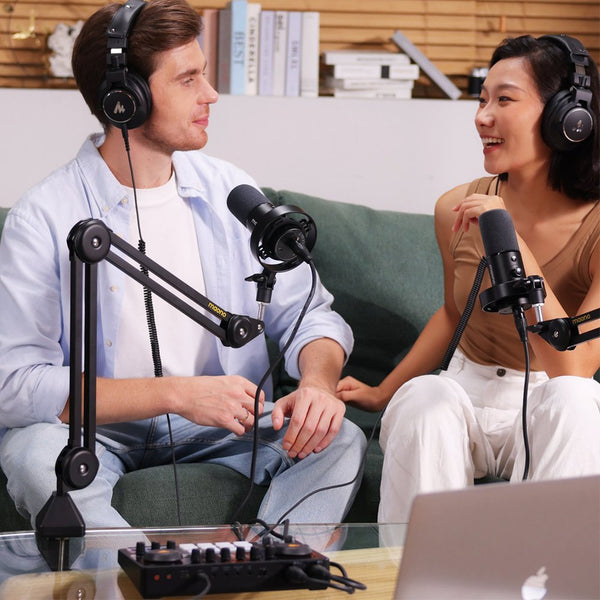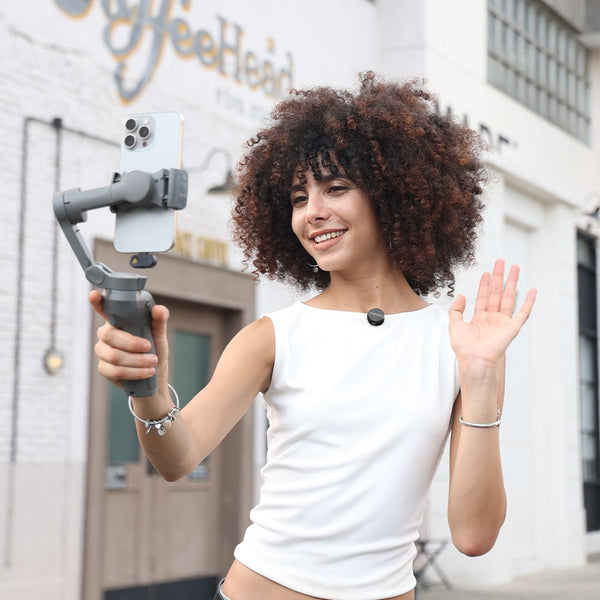Podcasting continues to thrive in 2025, with new creators entering the scene daily. Whether you're launching a solo show, an interview-based series, or a mobile vlog-style podcast, your podcast microphone choice plays a key role in how professional and engaging your content sounds. But with so many mic types out there—USB, XLR, and wireless—how do you choose the right one?
This guide compares each podcast microphone type, breaking down their pros, cons, costs, and best use cases to help you pick the best podcast microphone for your podcast setup in 2025.
Which Microphone Type Offers the Best Audio Quality for Podcasting?
There’s no single best podcast microphone for everyone. The right mic depends on your experience level, recording setup, content type, and budget. While an XLR microphone offers unmatched audio quality and is preferred by professionals, a USB condenser microphone provides plug-and-play convenience for beginners. Meanwhile, a wireless microphone is gaining popularity for video podcasters and mobile creators who need flexibility without cables.
Let’s explore what makes each mic type unique—and which is ideal for your goals.
Top Pros and Cons of USB, XLR, and Wireless Microphones
|
Microphone Type |
Pros |
Cons |
|
USB |
Easy setup, affordable, ideal for beginners |
Limited audio customization, tied to computer |
|
XLR |
Best audio quality, scalable, professional-grade |
Requires interface/mixer, higher upfront cost |
|
Wireless |
Great for mobile or video podcasts, no cables |
Battery-dependent, potential for interference |
Relevant FAQs:
1. What’s the difference between USB, XLR, and wireless microphones?
-
USB condenser microphones plug directly into your computer and often include built-in audio interfaces.
-
XLR microphones use three-pin connectors and require an audio interface or mixer.
-
Wireless microphones transmit audio over radio frequencies (UHF/2.4GHz) and are great for on-the-go recording or video-based content.
2. Why do professional podcasters prefer XLR mics?
An XLR microphone delivers studio-grade sound with low noise and better control over tone and dynamics. Paired with audio interfaces or mixers, they’re highly customizable—ideal for advanced podcasters seeking broadcast-quality audio.
3. Is a USB microphone good enough for starting a podcast?
Yes. A high-quality USB condenser microphone can provide crystal-clear audio, especially for solo podcasters or virtual interviews. It’s affordable, easy to use, and doesn’t require extra gear—making it perfect for beginners.
4. Should I invest in an expensive XLR setup or start with a USB mic?
Start with a USB condenser microphone if you’re new to podcasting. Once your show gains traction or you want to level up your audio quality, you can transition to an XLR microphone setup.
5. What’s the total cost of setting up an XLR mic system vs. USB?
-
USB mic setup: $50–$150 (mic + stand + pop filter) –cost depends on the brand of the mic
-
XLR mic setup: $59–$600+ (XLR microphone + audio interface + cables + accessories)
6. Can I grow my podcast using just a USB mic?
Absolutely. Many successful podcasts started with a USB condenser microphone. While an XLR setup adds polish, content quality, consistency, and audience engagement matter more in early stages.
Recommended Microphones for 2025:
What is the best budget microphone for podcasting?
Here are three top picks across mic types in 2025:
USB Pick: Maono AU A04
-
Type: USB Condenser Microphone
-
Polar Pattern: Cardioid
-
Notable Features:
-
Plug-and-play with Windows and Mac
-
Full podcast kit: shock mount, pop filter, boom arm
-
192kHz/24-bit resolution for high-fidelity audio
-
Why It’s Great:
-
Excellent value for beginners
-
Ideal for home studio podcasting
-
Clean, rich vocal clarity without extra gear
This usb condenser microphone is ideal for anyone who wants quality without complexity.
XLR Pick: Maono PD400X
-
Type: Dynamic XLR/USB Hybrid
-
Polar Pattern: Cardioid
-
Notable Features:
-
Dual USB/XLR output for flexible use
-
Real-time monitoring and 3-in-1 smart gain control knob and 1 tap to mute
-
Premium build is sturdy
-
Why It’s Great:
-
Professional-quality sound
-
Scalable—works with or without an audio interface
-
Perfect for long-term podcasters who want to grow
For many podcasters, this hybrid is the best podcast microphone for evolving setups.
Wireless Pick: Maono Wave T5 Wireless microphone
-
Type: Wireless Lavalier System
-
Transmission: Stable transmission up to 300 meters
-
Notable Features:
-
Dual transmitters and one receiver for two-person interviews
-
Up to 9 hours battery life and extend up to 30 hours with charging case
-
Real-time monitoring and noise cancellation
-
Why It’s Great:
-
Excellent for video podcasters, vloggers, and mobile creators
-
Clean audio with minimal interference
-
Compact, portable, and easy to set up on the go
This mic setup includes a mic lavalier, making it perfect for mobile creators.
What accessories do I need for each type of mic?
|
Mic Type |
Recommended Accessories |
|
USB |
Pop filter, boom arm, shock mount |
|
XLR |
Audio interface, XLR cable, stand, pop filter |
|
Wireless |
Lavalier mic, windscreen, mobile rig or mount |
These accessories improve audio clarity, comfort, and stability during your recording sessions. Condenser microphones, in particular, benefit from pop filters and shock mounts due to their sensitivity.
Which mic type is best for recording multiple podcast guests?
-
XLR microphones are best for multi-guest shows.
-
You can connect multiple XLR mics via an audio mixer or multi-input interface.
-
Wireless microphones, like the Maono Wave T5, also support dual-channel input—great for 2-person mobile setups.
Can I upgrade from USB to XLR without replacing my entire setup?
Yes, especially with hybrid models like the Maono PD400X. These combine both USB and XLR microphone connections, allowing you to start with USB and upgrade to XLR later.
Is a wireless mic more convenient for video podcasts or mobile recording?
Absolutely. Wireless microphones are ideal for:
-
Walking interviews
-
Vlogging
-
Video podcasts with movement
-
Remote location shoots
They eliminate the clutter of cables and offer freedom of movement—key for visual content creators using mic lavalier systems.
What mic type gives me the most flexibility for future podcast growth?
-
Hybrid XLR/USB mics like the Maono PD400X offer the most scalability
-
They let you start simply and grow into a professional studio-grade setup.
How do I decide which mic is best for my podcast goals and content type?
Ask yourself:
-
Are you podcasting solo or with guests?
-
Will you record in a fixed space or on the go?
-
Is video podcasting part of your plan?
-
What’s your initial budget?
|
Scenario |
Best Mic Type |
|
Solo beginner at home |
USB mic (Maono AU-A04) |
|
Interview podcast in studio |
XLR mic (Maono PD400X) |
|
Outdoor or video podcast |
Wireless mic (Maono Wave T5) |
Conclusion
Choosing the best podcast microphone in 2025 depends on your needs, experience, and long-term podcasting goals. A USB condenser microphone like the Maono AU-A04 is great for beginners seeking plug-and-play simplicity. For those ready to scale their setup, an XLR microphone like the Maono PD400X brings professional sound quality. And if you're filming on location or producing video content, a wireless microphone system like the Maono Wave T5—featuring a compact mic lavalier—is your go-to solution.
No matter which type you choose, investing in the right mic will elevate your podcast’s sound and presence—setting the stage for success in a competitive audio landscape.
Related Articles:
XLR vs USB Microphone: Which Is Best for Your Recording Needs?
XLR vs USB Microphone: Which is Best for Streaming & YouTube in 2024?



